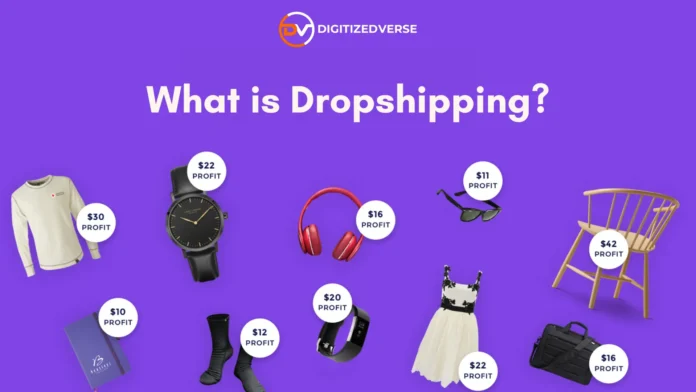If you’re looking for a way to start an online business with minimal upfront investment, dropshipping might be the perfect solution for you. But what exactly is dropshipping, and how does it work? In this comprehensive guide, we’ll walk you through the ins and outs of dropshipping, including how to set up your own online store, find suppliers, and market your products.
What is Dropshipping?
At its core, dropshipping is an order fulfillment method that allows you to sell products online without ever having to hold inventory. Unlike traditional retail, where you would purchase products in bulk and store them until they are sold, dropshipping eliminates the need for upfront inventory costs. Instead, when a customer places an order on your website, the supplier ships the product directly to them. This means you don’t have to worry about managing stock, shipping, or handling.
How Does Dropshipping Work?
Let’s break down how the dropshipping process works:
- You create an online store and list products for sale.
- A customer places an order in your store.
- You forward the order details to your supplier.
- The supplier fulfils the order by shipping the product directly to your customer.
Essentially, you act as the middleman between the customer and the supplier. Your job is to market the products and bring in sales, while the supplier handles the logistics of shipping and inventory.
Advantages of Dropshipping
Dropshipping offers several key benefits that make it an attractive option for aspiring entrepreneurs:
- Low Startup Costs: With no need to purchase inventory upfront, you can start your business with minimal investment.
- No Need for Storage: Since you don’t hold any inventory, you don’t need to rent warehouse space or manage stock levels.
- Flexibility: You can run your dropshipping business from anywhere with an internet connection, giving you the freedom to work on your own terms.
- Wide Product Selection: You can offer a broad range of products without the need to physically stock them.
Disadvantages of Dropshipping
While dropshipping has its perks, it’s important to be aware of the potential downsides:
- Lower Profit Margins: Since you’re not buying products in bulk, your profit margins may be lower than those of traditional retailers.
- Reliance on Suppliers: Your business is dependent on the reliability of your suppliers. Delays in shipping or stock shortages can lead to unhappy customers.
- High Competition: The low barrier to entry means that dropshipping is a highly competitive market, and standing out can be challenging.
Finding a Niche for Your Dropshipping Business
Choosing the right niche is critical to the success of your dropshipping store. A niche refers to a specific segment of the market that caters to a particular audience. Here’s how to find your niche:
- Follow Your Passion: The most successful dropshippers often choose niches they are passionate about. For example, if you love pets, consider starting a pet supply store.
- Research Market Demand: Use tools like Google Trends and keyword research to find out what products are trending and in demand.
- Consider Profitability: Look for niches that have a healthy balance of demand and competition. Avoid markets that are too saturated, but also steer clear of niches with little interest.
How to Find Dropshipping Suppliers
Your suppliers play a crucial role in the success of your dropshipping business. Here are some tips for finding reliable suppliers:
- Use Dropshipping Platforms: Platforms like AliExpress, Spocket, and SaleHoo connect you with suppliers that specialize in dropshipping.
- Research and Vet Suppliers: Always do your due diligence by checking reviews, ratings, and customer feedback before partnering with a supplier.
- Consider Domestic Suppliers: Depending on your market, you might want to work with local suppliers to reduce shipping times and improve customer satisfaction.
Setting Up Your Online Store
Once you’ve chosen your niche and found suppliers, it’s time to set up your online store. Here are the steps you’ll need to take:
- Choose an E-commerce Platform: Popular platforms like Shopify, WooCommerce, and BigCommerce make it easy to create an online store without any coding knowledge.
- Design Your Store: Select a clean, professional design that reflects your brand and appeals to your target audience.
- Add Products: Import your products from your suppliers, making sure to include high-quality images and detailed descriptions.
- Set Up Payment Gateways: Ensure that your customers have a variety of payment options, such as credit cards, PayPal, and more.
- Optimize for SEO: Make sure your store is optimized for search engines by using relevant keywords, adding meta descriptions, and improving site speed.
Marketing Your Dropshipping Store
Once your store is up and running, you’ll need to drive traffic to it. Here are some effective marketing strategies for dropshipping:
- Social Media Marketing: Platforms like Facebook, Instagram, and TikTok are great for reaching your target audience and promoting your products.
- Paid Advertising: Use Google Ads, Facebook Ads, and Instagram Ads to target specific demographics and drive traffic to your store.
- Email Marketing: Build an email list of potential customers and use it to send promotions, product updates, and more.
- Content Marketing: Create blog posts, videos, and other content that provides value to your audience and helps boost your SEO.
Common Mistakes to Avoid in Dropshipping
While dropshipping is an accessible business model, there are some common pitfalls to avoid:
- Choosing the Wrong Niche: Avoid picking a niche solely based on profitability without considering your passion or expertise.
- Not Testing Products: Before committing to a product, test it out by ordering samples to ensure quality.
- Ignoring Customer Service: Good customer service is crucial for retaining customers. Make sure to respond promptly to inquiries and resolve any issues quickly.
Scaling Your Dropshipping Business
Once your dropshipping business is up and running, you’ll want to start thinking about how to scale it. Here are some tips:
- Automate Processes: Use tools and software to automate tasks like order processing, inventory management, and customer service.
- Expand Your Product Range: Introduce new products to your store to attract more customers and increase your sales.
- Invest in Advertising: As your business grows, increase your ad spend to reach a larger audience and drive more traffic to your store.
Conclusion
Dropshipping offers a low-risk, high-reward opportunity for aspiring entrepreneurs looking to start their own online store. By following the steps outlined in this guide—choosing the right niche, finding reliable suppliers, setting up your store, and marketing effectively—you can build a successful dropshipping business. Remember, while dropshipping can be profitable, it’s still a business that requires time, effort, and commitment. So, start small, learn as you go, and keep scaling as you grow.
Good luck, and happy dropshipping!





